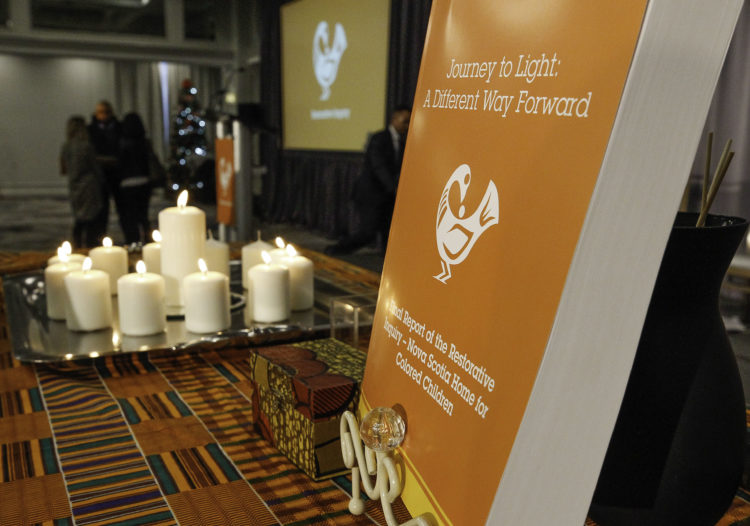
The Restorative Inquiry for the Nova Scotia Home for Colored Children released its final report at a public ceremony in Halifax in November 2019. The 556-page report details the work and outcomes of this first public inquiry in the world to take a restorative approach. After former residents brought to light their experiences of abuse and neglect at the Home, the inquiry was established to bring those involved together — to learn what happened at the Home and why; and to understand and accept their responsibilities for what happened and for what needs to happen to make things right for the future.
The Nova Scotia Home for Colored Children was established in 1921 as a private child welfare institution for African Nova Scotian children in need of care. Supported by public funding and private donations, the Home shifted from an orphanage to a group home over the decades before ceasing operations in 2014. From its inception, the Home was held up as a significant achievement in the African Nova Scotian community, representing an effort to ensure care and “racial uplift” for its young people and the community as a whole. However, in 1998 former residents began to come forward to share their negative experiences within the Home. They were met with denials and silence from authorities and the community.
Following the settlement of a class action lawsuit brought by former residents, Nova Scotia’s premier, Stephen McNeil, gave a public apology in 2014. He acknowledged the Home was not only an example of institutional abuse within the care system but also “one chapter in a history of systemic racism and inequality that has scarred our province for generations.” He promised the apology was not “a closing of the books, but a recognition that we must cast an unflinching eye on the past as we strive toward a better future.” To that end, and at the request of former residents, the government established a public inquiry into the experiences, impacts and legacy of the Home in 2015.
While public inquiries into institutional abuses and failures are nothing new, this one took a different approach. Public inquiries are typically led by a judge and mandated to investigate. They usually take testimony, make findings and offer recommendations for government action. As its tag line, “A different way forward,” reflects, the Restorative Inquiry did not offer the familiar and expected trappings of adversarial processes aimed at ascribing blame. But this does not mean it was not concerned with accountability and justice.
Former residents of the Home sought a process that would do no further harm, place their experiences at the centre and make a real and lasting difference for the future. They were guided by the wisdom of Sankofa — a principle captured by the symbol of a bird with its feet facing forward, craning its neck back to gather an egg in its beak to bring it along as it journeys forward. Sankofa means “It is not taboo to go back and fetch it.” This was what justice required for the former residents: looking back to take account of the past and carrying its lessons forward into the future to make a difference.
The province agreed to establish a restorative public inquiry designed through a collaborative process involving former residents, the government and members of the African Nova Scotian community, including those connected to the leadership of the Home. The inquiry was led by commissioners working as a “council of parties” and included representation from these parties most closely connected to the history of the Home. As described in its report and accompanying videos, the inquiry undertook three phases of work, focused on relationship building, learning and understanding, and planning and action.
Former residents were clear they were not looking for a process focused on “naming, blaming and shaming.” The decision not to focus on blame has been misunderstood by some as a compromise or as the result of former residents settling for less. This misunderstanding is rooted in the deeply held and mistaken assumption that blame is the only or best route to accountability, responsibility and justice.
But no one who took up the invitation to participate in the inquiry, who reads its report or who listens to those who participated (including the Premier’s speech at the closing ceremony) can conclude there is a lack of culpability or accountability — at least not if what is meant is a condemnation of the harmful experiences and failures related to the Home and an understanding of associated responsibilities. It is true that the inquiry was not an exercise in “calling people out.” Rather it focused on ensuring meaningful accountability by calling people into the process to understand their roles and responsibilities for the past and the future.
Those who envisioned the inquiry knew it was a mistake to conflate blame with responsibility. The inquiry report offers a detailed and clear picture of what happened at the Home and does not shy away from the very nuanced and complicated story of why and how harm happened. This approach is particularly important because of the complexity of responsibility in this case. Individual responsibility cannot be understood outside the context of collective responsibility for systemic racism in the province.
The inquiry thus offered justice measured not by naming, blaming and shaming but by how people or parties showed up in the process and in the planning and action that resulted. The inquiry report reflects this work of planning and action that is under way. It did not need to mete out accountability. Rather, it facilitated the parties most connected to the history of the Home and its impacts to take action, develop plans and make commitments to the pathways forward.

The report does not contain simply a list of recommendations for government. Rather, it describes the pathways forward as a road map providing information, guidance and support for the journey ahead. The elements of the way forward identified in the report reflect what parties came to learn and understand about making a shift to a human-centred approach that they determined is essential to make a difference on the central issues of concern to the inquiry: systemic racism, the experience of the care system and responding to institutional abuse and other failures of care. The actions, plans, commitments and recommendations in the report are rooted in the overarching commitment to a different way of doing things — to fundamental shifts in ways of thinking and working at systemic and structural levels.
For example, one of the pathways is a commitment to family-led decision-making as a central commitment across the system of care. Young people and their families will have a central role in decision-making about their care, and care systems and services will be reoriented to support their care plans and activities. Another pathway recognizes the significance of a restorative approach for former residents, particularly when compared with their difficult and harmful experience seeking justice through the civil justice system. The pathway identifies the need for a shift in the response of the justice system to future cases of institutional abuse and failures of the care system. One way in which this shift will be supported is through the adoption of guidelines that reflect and articulate the commitment to make a different way— a restorative approach —the default government response to such cases in the future.
The various parties across government and community are now accountable for following through on the actions, plans and commitments made to one another during the inquiry process. This is the true measure of accountability: the responsibility we carry to make things right, to do justice. This is the journey to light envisioned by the former residents and detailed in the inquiry’s report.
The Restorative Inquiry has offered a different way forward in Nova Scotia to ensure the lessons from the Home for Colored Children make a difference for young people, families and communities. It also offers a significant model of doing justice differently that is applicable to so many of the complex human challenges we face.
Photo: Nova Scotia Premier Stephen McNeil, left, embraces Tony Smith, one of the commissioners of the Nova Scotia Home for Colored Children Restorative Inquiry, at a ceremony marking the final report on the facility in Halifax on Nov. 28, 2019. Smith and many others suffered abuse as residents at the Dartmouth, N.S. orphanage. THE CANADIAN PRESS/Andrew Vaughan
Do you have something to say about the article you just read? Be part of the Policy Options discussion, and send in your own submission. Here is a link on how to do it. | Souhaitez-vous réagir à cet article ? Joignez-vous aux débats d’Options politiques et soumettez-nous votre texte en suivant ces directives.









